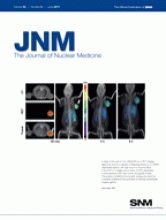Abstract
N,N-dimethyltryptamine (DMT), a strong psychodysleptic drug, has been found in higher plants, shamanic hallucinogenic beverages, and the urine of schizophrenic patients. The aim of this work was to gain better knowledge on the relationship between this drug and hallucinogenic processes by studying DMT behavior in comparison with tryptamine. Methods: 131I-labeled DMT and tryptamine were injected into rabbits. γ-Camera and biodistribution studies were performed. Brain uptake, plasma clearance, and renal excretion were assessed for each indolealkylamine. Results: DMT and tryptamine showed different behavior when brain uptake, residence time, and excretion were compared. Labeled DMT entered the brain 10 s after injection, crossed the blood–brain barrier, and bound to receptors; then it was partially renally excreted. It was detected in urine within 24 h after injection and remained in the brain, even after urine excretion ceased; up to 0.1% of the injected dose was detected at 7 d after injection in the olfactory bulb. In contrast, tryptamine was rapidly taken up in the brain and fully excreted 10 min after injection. Conclusion: To our knowledge, this is the first demonstration that exogenous DMT remains in the brain for at least 7 d after injection. Although labeled DMT and tryptamine behave as agonists for at least 5-hydroxytryptamine 2A receptor, 5-hydroxytryptamine 2C receptor, trace amine-associated receptor, and σ-1 putative receptor targets, binding to the latter can explain the different behavior of labeled DMT and tryptamine in the brain. The persistence in the brain can be further explained on the basis that DMT and other N,N-dialkyltryptamines are transporter substrates for both the plasma membrane serotonin transporter and the vesicle monoamine transporter 2. Furthermore, storage in vesicles prevents DMT degradation by monoamine oxidase. At high concentrations, DMT is taken up by the serotonin transporter and further stored in vesicles by the vesicle monoamine transporter 2, to be released under appropriate stimuli. Moreover, the 131I-labeling proved to be a useful tool to perform long-term in vivo studies.
- © 2011 by Society of Nuclear Medicine







